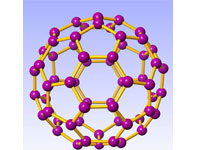
日本东京大学的研究人员首次开发出了利用超小球形碳分子C60(富勒烯)导入基因的新技术。该技术有望为糖尿病患者带来福音。
C60是60个碳原子结合在一起形成的直径不足1纳米的球状微小粒子。东京大学副教授野入英世和教授中村荣一率领的研究小组让C60携带4个氨基,制造出了水溶性C60,使其与基因结合成为可能。
研究人员将结合了绿色荧光蛋白基因的水溶性C60注射到实验鼠体内。结果发现实验鼠的肺、肝和脾都出现了该基因,证实了水溶性C60具有强大的基因运载能力。在随后的实验中,研究人员让水溶性C60携带指导合成胰岛素的基因进入实验鼠体内,结果实验鼠体内的胰岛素水平增加到平常的1.5倍,血糖值也降低了20%以上。
研究人员介绍说,与基因结合的水溶性C60穿过细胞膜以后就会与基因分离,随尿液排出体外,不会在体内堆积。
目前,治疗糖尿病的手段主要是通过给患者直接注射胰岛素来降低血糖值。日本研究人员认为,此次开发的新技术达到实用化水平后,降低血糖值效果的持续时间将比直接注射还要长,由此将大大减轻患者的负担。另外,这项新技术还有可能促成安全性更高的基因治疗糖尿病方法的出现。
这一研究结果已刊登在美国《美国科学院院刊》(PNAS)网络版上。
生物谷推荐原文出处:
PNAS doi: 10.1073/pnas.0909223107
In vivo gene delivery by cationic tetraamino fullerene
Rui Maeda-Mamiyaa,b, Eisei Noirib,1, Hiroyuki Isobec, Waka Nakanishic, Koji Okamotob, Kent Doib, Takeshi Sugayad, Tetsuro Izumie, Tatsuya Hommaa, and Eiichi Nakamuraa,1
Application of nanotechnology to medical biology has brought remarkable success. Water-soluble fullerenes are molecules with great potential for biological use because they can endow unique characteristics of amphipathic property and form a self-assembled structure by chemical modification. Effective gene delivery in vitro with tetra(piperazino)fullerene epoxide (TPFE) and its superiority to Lipofectin have been described in a previous report. For this study, we evaluated the efficacy of in vivo gene delivery by TPFE. Delivery of enhanced green fluorescent protein gene (EGFP) by TPFE on pregnant female ICR mice showed distinct organ selectivity compared with Lipofectin; moreover, higher gene expression by TPFE was found in liver and spleen, but not in the lung. No acute toxicity of TPFE was found for the liver and kidney, although Lipofectin significantly increased liver enzymes and blood urea nitrogen. In fetal tissues, neither TPFE nor Lipofectin induced EGFP gene expression. Delivery of insulin 2 gene to female C57/BL6 mice increased plasma insulin levels and reduced blood glucose concentrations, indicating the potential of TPFE-based gene delivery for clinical application. In conclusion, this study demonstrated effective gene delivery in vivo for the first time using a water-soluble fullerene.







